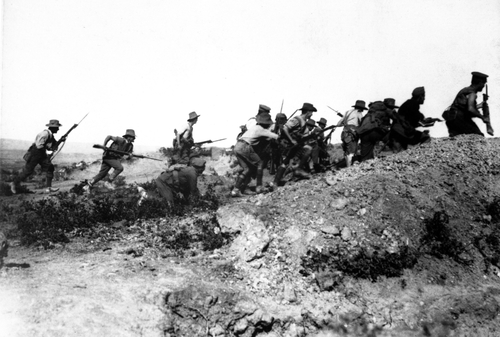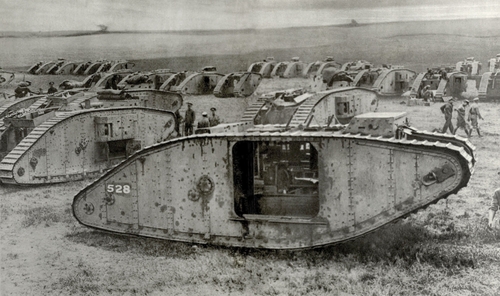The Great War, or the 1st World War as it is more commonly called, was the first war that involved more than armies and navies slugging it out on land and sea. Between 1914 and 1918 most of the population of Europe was involved in some way. Apart from them being directly affected by the fighting and the new terror of aerial bombardment from Zeppelins and aircraft, many people were employed in factories producing weapons and ammunition, and building ships, aircraft and new fighting machines such as tanks. By 1915 the whole of the United Kingdom economy was geared to fighting the war against Germany and its allies. Not surprisingly, scientists from both sides of the war became involved.
In previous wars, scientific activity had continued almost unaffected. For example, during the Napoleonic wars in the early nineteenth century, the famous British scientist, Humphry Davy went on exchanging letters with his scientific friends in France. In 1813, two years before the Battle of Waterloo ended the war, he travelled with his wife and assistant, Michael Faraday, to Paris where he was warmly welcomed. All that changed in the Great War. Scientists on both sides joined their respective armed forces while others looked at ways to support their country’s military efforts.
The war presented a problem for the Royal Swedish Academy of Sciences that selects the winners of the Nobel Prizes. Sweden was a neutral country and wished to remain in a friendly relationship with both sides of the conflict. The selection committee thus tried to be balanced in their awarding of the prizes to scientists from each side. They had two rules that could help them. The first was that they could put off awarding a prize for a year. After another year had passed they could decide not to make any award at all. The panel for the Medicine prize took this latter choice from 1915 to 18, but the Physics and Chemistry panels hedged their bets a little, awarding the prize a year late on some occasions and only failing to make an award for three out of ten prizes.
Despite the Swedes’ best efforts there were some controversial decisions and also some names missing from the list of Nobel laureates. One name that was expected to appear was Henry Moseley. We have discussed Moseley before. His research on the X rays emitted by elements showed the fundamental nature of the atomic number of an element and was one of the astounding discoveries of 1913.
Moseley was born in 1887 in Oxford where his father was a university professor. Having attended Eton College he returned to Oxford to study for his degree. His love for Oxford meant that he was expected to make his career there but in 1910 he went to Manchester to work in Ernest Rutherford’s laboratory. This was where exciting discoveries in radioactivity and the structure of the atom were being made. In 1912 Moseley became interested in X rays. Up to that time it was still not known whether X rays were particles or a form of electromagnetic wave but that year, Max von Laue, a German physicist, showed that X-rays could be diffracted by crystals. Diffraction is a property of waves. In Leeds the father and son team of William and Lawrence Bragg, who had previously thought that X rays were particles, picked up the idea.
Moseley, together with a colleague who was a grandson of Charles Darwin, were sent to Leeds to learn about X rays. Moseley was soon building his own apparatus and making experiments. He arrived at a method of determining the frequency of the X rays from the diffraction pattern of a crystal just a few days after the Braggs. Moseley then turned to some work done by Charles Glover Barkla at Kings’ College in London. Barkla had found that different metals gave out X rays capable of passing through different thicknesses of aluminium sheet and there seemed to be some relationship to the order of the metals in the Periodic Table.
Moseley swiftly constructed his X ray spectrometer that allowed him to measure the frequencies of X rays emitted by sequences of elements in the Periodic Table. In 1913 he published his results that supported Rutherford’s and Bohr’s idea that the atom has a nucleus and carries a positive charge equal to the element’s atomic number. Moseley returned to Oxford to continue his work, hailed by chemists and physicists as one of the greatest experimental scientists of the period.
Moseley was expected to take over from the ageing professor of physics in Oxford but then the war began. He was actually at a conference in Australia when war was declared in August 1914. He took the first ship travelling home, and like many other young men, enlisted in the army. In October 1914 he started training as a signals officer. In June 1915 he was sent to Gallipoli in the European part of Turkey to assist in the allied invasion. His main job was to lay telephone lines between the front line and the control centre.
Gallipoli was one of the most disastrous actions of the Great War. Between April 1915 and January 1916, over 46,000 Allied soldiers (10% of the invasion force) died, among them Henry Moseley. (A similar number of Turks and their allies were also killed).
Rutherford, among others, was appalled at the waste of Moseley’s life and made sure his death received publicity in the newspapers. The British government had also begun to realise that, in this new type of war, scientists were too valuable to be sent to the front line. They were needed to develop new weapons, new forms of communication (radio was just beginning to be used), new treatments for wounded servicemen, and many other areas. After Moseley’s death, promising young scientists were directed to the research establishments set up by new bodies such as the Admiralty’s Board of Invention and Research. The scientific war had begun.
Meanwhile, in 1915, Moseley had already been nominated for the Nobel Prize in Physics by Svanté Arrhenius, an important Swedish scientist. The Nobel committee had delayed announcing the 1914 prize but in 1915 they awarded it to Laue with the 1915 prize going to the Braggs. Surely 1916 would have been Moseley’s turn. However because he died in August 1915 the prize could not be awarded to him (The Nobel prize is only presented to living scientists). No Physics or Chemistry award was made in 1916.
Perhaps Moseley’s work deserved a chemistry or a physics prize earlier. It certainly had a dramatic influence on both sciences. Today the prizes are rarely awarded less than a decade after the research took place but it was more common in the early days of the prize such as in the case of the Braggs. There was one surprising consequence of Moseley’s missed prize. The Swedish Academy delayed the award of the 1917 Physics Prize but in 1918 awarded it to Charles Barkla on Rutherford’s nomination. While Moseley had built on Barkla’s work there is doubt that Barkla’s research deserved the prize on its own merit. By 1918 Barkla was an ignored and derided figure as he had some ideas about X rays that no other physicist accepted. Rutherford probably supported Barkla’s nomination in order to publicise Moseley’s achievement.
What of the other controversies in the wartime Nobel prizes? – well, they’ll come later.
Activities
1. Find out more about Moseley’s life and death (visit the MHS website, no. 1 below).
2. Moseley wasn’t the only scientist to enlist and die in the war. Why do you think young men rushed to join the armies (of both sides)?
3. The Admiralty Board of Invention and Research and similar bodies became the science research councils that exist today to support scientific experiments such as the Large Hadron Collider. Why do you think these bodies were formed?
4. In what ways did scientists assist the war effort (on both sides)? Find out about the inventions involving chemistry and physics that were made during the First World War.
5. (a) Why do you think Moseley deserved a Nobel Prize?
(b) How would you justify awarding the prize to Moseley before he died?
(c) What reasons are there for and against awarding Nobel Prizes during the war?
Bibliography
- “’Dear Harry. . .’ Henry Moseley: A Scientist Lost to War” exhibition and website at the Museum for the History of Science, Oxford. http://www.mhs.ox.ac.uk/moseley/
- “Harry’s Nobel Prize” unpublished lecture by Prof J.L.Heilbron (Moseley’s biographer) at the Museum for the History of Science, 25th August, 2015.
- Battle of Gallipoli, http://www.history.com/topics/world-war-i/battle-of-gallipoli
- Science and the First World War, illustrated talk by Prof Jon Agar, UCL, London available to view on http://blogs.ucl.ac.uk/events/2014/07/09/science-and-the-first-world-war/
- Information about the Nobel Prizes awarded during the 1st World War. http://www.nobelprize.org/
- Oxford Dictionary of Scientists, pub. OUP




